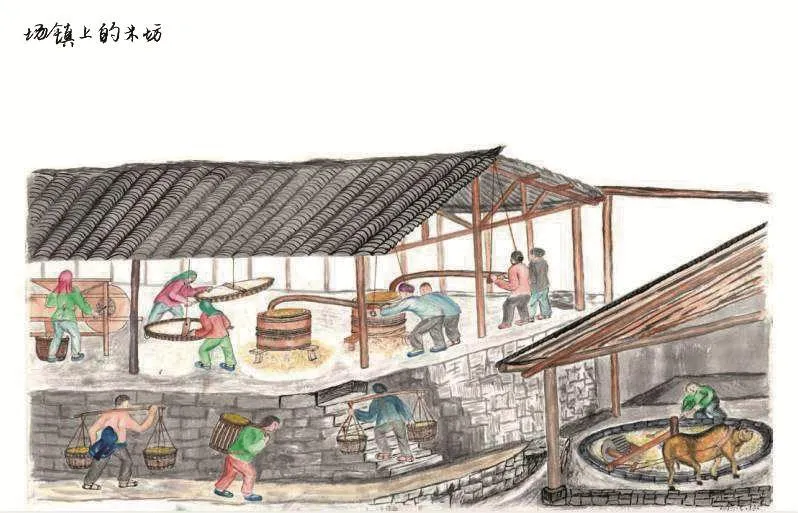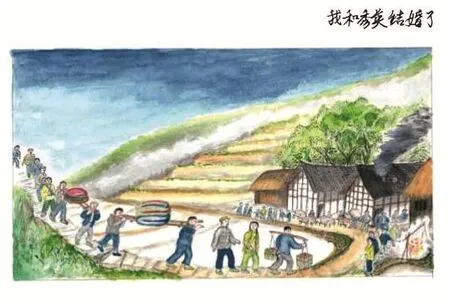与现实隔着温暖的距离
2017-11-01◇文|田东
◇ 文| 田 东
与现实隔着温暖的距离
◇ 文| 田 东

年近古稀,大病初愈,生活无忧。
如果是你,你会选择怎样度过晚年?旅旅游、带带孙?还是跳跳舞?
如果张才柱老人也选择这样的生活,对他来说没什么损失。可对你,对我,对很多80后、90后甚至00后来说,损失还真不是一般的小。
我们或许会错过一次穿越回五六十年前重庆农村的时光之旅。
If you hit seventy while recovering from some serious illness with little to worry about, how do you spend your rest life? Travel, open-air square dance, or taking care of your grandchildren?
If our revered Mr.Zhang Caizhu also chose such a life, there was no loss to him but to many people just like you and me who wereborn in 1980s ,1990s or even 2000s.
Maybe, we will miss a time-journey to get back to the countryside in Chongqing as fifty or sixty years ago.
北碚乡间的日常
Daily Life in Countryside of Beibei
翻开这本“书”,只需要一个晚上,你就能领略上世纪五十年代到八十年代初北碚乡村的隐秘日常。在这趟旅行中,你可以看到父辈、爷爷辈年轻时在静观场赶场的身影,听到一群小崽儿一边放牛、一边玩镰刀打叉赢猪草游戏的欢笑。
油坊榨油、挖桐子米、扯竹麻、做蓑衣、打席子、补锅、打铁、打纸、烧炭……许多现在很难看得到的农村生产活动在这里重现:挑肥料上梁子、大炼钢铁送喜报、和猪牛在一个屋檐下吃饭睡觉、与三四个甚至五六个哥哥姐姐、弟弟妹妹挤在一张床上,半夜流尿打湿的裤子,随手搭在屋中间的烘罩上烤干,大人小孩举起竹竿吆麻雀、每家人派个代表到公社食堂排队打饭吃集体伙食……
那些你也许曾经历过,也许听说过,或者从不曾耳闻却真实发生过的往事——不只关乎个人,而是这个国家——现在只需要不到60块,就能看到。
对,是看到,而不是读到。
和一些回忆性的书籍以文字为主不同,这本名为《往事入画——一个老人的记忆博物馆》的书,主体是一百三十多幅画,翻阅之间,一种电影般的既视感扑面而来。
Browse this “book”only for one night, you can have a look at the daily life concealed in countryside of Beibei from the 1950s to the early 1980s.Your fathers and grandfathers were still young,going on village fairs in Jingguan, and the mirth of a group of children playing a game to win more hogweeds while herding cattle at the same time comes to you.
Refining oil in a mill, collecting seeds of Tung oil trees, pulling bamboo hemps, making raincoats, weaving mats,tinkering pans, forging iron, making paper,burning wood for charcoal…And many rural production activities hardly seen now can be revived in this book: carrying manure to the ridge of a hill, delivering a glad message about steel-making activity,eating and sleeping with pigs and cattle under the roof, sharing one bed with several siblings.When wetting the bed at midnight, the children could put the pants on the basketwork brazier; adults and children shooed away the sparrows with a bamboo pole;each family sent a representative to the commune canteen to queue for the food.
All of these memories you may have experienced, heard or never heard of but actually happened (not only related to individuals but all about this country) now only costs you less than 60 Yuan to see.
That's true.You can see it other than reading.
Different from reminiscent books based on words, the book bygone days in painting——a man’s museum of memory is mainly presented by more than one hundred and thirty paintings.The right sight of the book gives a feeling of watching a movie.
苍老而灵巧的画手
A Pair of Wrinkled but Deft Hands
感谢张才柱老人,这位1946年出生在北碚中嘴(现重庆市北碚区三圣镇亮石村)乡下的老人,虽毫无绘画基础,却付出了两三年心血。感谢他在66岁时,没有去跳坝坝舞,没有打麻将泡茶馆,双眼视力仅有零点几,却用一双苍老但灵巧的手,将自己记忆中的往事入画。
当年,这双手可以组装收音机、电视机,还为他赢得了一位18岁姑娘的芳心。现如今,这双手调和色彩,涂抹时光,给我们带来一册昔日岁月的风情画。
全书分为七个部分,既有老人对童年生活的追忆,也有对当时乡村生活的再现,那时的集体生产、风俗、农事、副业,还有那时的运动,那时的辛苦。
比如,张才柱还是小娃儿时,和邻居好友春娃儿去高家庙赶场,最想看西洋镜,“它有点像望远镜,里面有很多好看的图片,看完一张就用手转动一下,再看第二张。看西洋镜要两分钱,可是我身上没有钱,只能眼巴巴地站在旁边。经营西洋镜的女人可怜我,过一会儿就让我看一眼。”
到了中秋节,“家家都要烧橙香。把香插到橙子上,每个橙子上大约插十多支,然后把橙子插到竹竿上,对着月亮升起的方向,把两根长竹竿立起来。下面摆上供桌,摆上月饼、供果、茶水,全家人对着月亮祭拜。完了还要给去世的亲人烧纸钱。”这样的习俗,不知道现在的乡村还有没有,在城里还真的没见过了。
当然也少不了那时的人。童年的玩伴、好心的邓队长、刁难的文书、坏坏的“坏老幺”、偷谷子的唐光兴、命苦的颜顺华……
Thanks Mr.Zhang Caizhu, who was born in Zhong Zui(now in Liang Shi village of Sansheng town of Beibei district, Chongqing) in 1946.Although he knew nothing about painting, he has paid two or three years’ efforts.We really appreciate him, for at the age of 66, he didn’t go to square dance, play mahjong or dawdle in the teahouse, and instead,he drew these bygone days in his memory on the paper with his wrinkled but deft hands and little vision in both eyes.
In the past, his hands could assemble radio and television and also won him the heart of an eighteen-yearold girl.Now, his two hands bring us a volume of paintings that record the landscapes and customs of past days by harmonizing colors as well as memories.
The whole book consists of seven parts,containing both his recollection of childhood and the reappearance of countryside life then.Such as the collective production,customs, farm work, sidelines, campaigns and pains.
For instance, when he was a child, accompanied by his good neighbor friend Chun to Gaojia Temple on marketday, he wanted most to try the zoetrope.“It was a trifle like telescope containing many fascinating pictures inside.Twirling it after finished one and then came another picture.It required two cents but I had none, so I stood by it with eager eyes.The woman owner sympathized me and let me try once for a little while.”
During mid-autumn festival, “each family would burn incensestuck into oranges, with about ten on each orange.Then the oranges were stuck to the pole of the bamboo and two bamboos were stood facing the moon.A table was placed under the bamboos, with moon-cakes, fruits and tea on it.The whole family worshiped the moon for welfare and then burned paper money in honor of the dead.” This custom has probably gone in countryside, after all, hardly seen in cities now.
Obviously, people at that time cannot be neglected.Pals of childhood, kind-hearted header Deng, cunning Wen Shu, sly Lao Yao, Tang Xing stealing crops and Shun Hua of a bitter life.
与现实隔着温暖的距离
Between Memory and Real Life Then
我不是美术科班出身,只觉得画里的色彩非常漂亮,淡淡的蓝天白云,远处的青山,近前的稻田,劳作着或休息着的乡亲……老人喜欢用红色和绿色来渲染人物的穿着,还有,秧苗是绿的,竹林是绿的,稻谷是黄的,街道是土黄或铁灰的。好点的房子,墙是白的,差点的,墙是土黄的,欢腾的溪水是白的……
有人说,老人画中的颜色是梦幻的。的确,斑驳的色彩,给那时的艰难装饰了几抹亮色,也映出了张才柱老人内心的乐观。其实这些画是老人记忆中的那个年代,和真实的生活,还隔着一个温暖的距离。
从另一个角度来说,老人用他的画笔,把当时那些被冰冷包裹着、压迫着的温暖,像开春犁田翻土一样给翻了出来。
我想,对这些,张才柱老人可能没有自觉,这从他朴实的“解说词”中就能看出来。他只是忠于内心涂着画着写着,流淌着真诚与温情。这也是我们这个国家,这个民族的底色,不论在什么时候,都顽强地在我们不曾注意的地方生长着。
当然了,老人的画里还是有几幅只有一种色调——黑。至于为什么,是批判还是表现,聪明的读者自有评说了。
最后,搜肠刮肚凑得打油诗一首,献给老先生,以表敬意——
六旬老汉提画笔/重现时光记往昔/赤橙黄绿青蓝紫/点面结合实与虚/经年风雨勾画间/故旧乡俗涂抹里/一笔一划现真心/画里话外总关情
Having not majored in art, I could still find the hue very beautiful in those paintings with pale blue sky and white clouds above, green mountains afar, crop fields near and folks laboring or resting.Mr.Zhang is fond of applying red and green to render the dressing of characters.What’s more, the rice seedlings are verdant, bamboo grove green,crops golden, streets yellowish brown or iron-gray, the walls of fine houses white while earthy yellow of badlyconditioned ones, exultant stream white and so on.
Some say the colors of his paintings are dreamlike.Truly, the mottled colors decorate the hard time and also reflect his inner optimism.Actually these paintings mirror those years in his memory and are still mildly different from the real life then.
From other point of view, with a paintbrush, he recalls and records the warm memories wrapped and oppressed by ice-cold reality, which is just like turning the soil in early spring.
Judging from his plain commentary, Zhang Caizhu may not be aware of this.He devotes himself to paintings with mere sincerity and tenderness.It is this very feature of our country and nation that grows tenaciously somewhere without our notice.
Sure, there are still some paintings bearing only one color--black.Whether it is about criticism or manifestation is what left to the smart readers.
Finally, I would like to write a ragged verse to him, to show my respect.
A man of sixty picks up paintbrush to recall the time passed,
With all bright colors applied, reality and memory combined.
Past tribulation and old customs emerge from the paintings.
Each stoke presents his sincerity,
And the paintings and their meanings show his affection.
A Mild Difference betweenMemory and Reality
Article | Tian Dong


